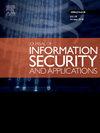利用像素移动方法(PSA)在加密图像中进行可逆数据隐藏
IF 3.8
2区 计算机科学
Q2 COMPUTER SCIENCE, INFORMATION SYSTEMS
Journal of Information Security and Applications
Pub Date : 2024-11-05
DOI:10.1016/j.jisa.2024.103909
引用次数: 0
摘要
本研究提出了一种在加密图像中可逆嵌入数据的新技术,特别是利用像素移动方法(PSA)。传统的数据隐藏方法通常是修改原始图像中像素的最小有效位(LSB)。相比之下,使用加密封面图像的方法提供了更广泛的数据隐藏技术,不受 LSB 修改的限制。所提出的数据隐藏方法是将数据嵌入加密的封面图像,方法是将图像划分为非重叠块,然后根据定义的规则对每个块内的像素进行排列,而不是修改像素的 LSB。数据嵌入后,图像的熵保持不变,因此很难检测到隐藏数据的位置。为了提取隐藏数据,需要对加密图像进行解密,并测量每个区块的平滑度。平滑度最低的块被识别为包含隐藏数据的块,也就是原始块。这是因为每个区块内的像素与其他区块相比具有不同的统计特性,因此可以恢复数据。所提出的方法具有每个区块可嵌入 4 比特数据的优势,其性能超过了现有的修正像素移动方法(MPSA)。此外,偷窃图像的熵保存与 MPSA 相当,而算法的执行时间更有效。与 MPSA 相比,该算法的数据隐藏规则更简单,编码和解码速度更快。在从偷窃图像中提取数据并还原原始图像时,通过保留每个块内像素之间的相关性,保证了可逆性。实验结果表明,所提出的方法在数据隐藏效率和安全性方面明显优于现有技术。本文章由计算机程序翻译,如有差异,请以英文原文为准。
Reversible data hiding in encrypted images using Pixel Shifting Approach (PSA)
This study proposes a novel technique for reversibly embedding data within encrypted images, specifically utilizing a Pixel Shifting Approach (PSA). Traditional data hiding methods commonly employ the modification of the least significant bits (LSBs) of pixels in the original image. In contrast, methods using encrypted cover images offer a wider range of data hiding techniques that are not constrained by LSB modifications. The proposed data hiding method embeds data into an encrypted cover image by dividing it into non-overlapping blocks and then permuting pixels within each block according to a defined rule, rather than modifying the LSBs of pixels. The entropy of the image remains preserved after data embedding, making it difficult to detect the location of hidden data. To extract the hidden data, the encrypted image is decrypted, and the smoothness of each block is measured. The block with the lowest smoothness is identified as the one containing the hidden data, which is also the original block. This is because the pixels within each block have different statistical properties compared to other blocks, allowing for data recovery. The proposed method offers the advantage of embedding 4 bits of data per block, surpassing the performance of the existing Modified Pixel Shifting Approach (MPSA). Moreover, the entropy preservation of the stego-image is comparable to MPSA, while the algorithm’s execution time is more efficient. The simpler data hiding rule compared to MPSA enables faster encoding and decoding. Reversibility is guaranteed by preserving the correlation among pixels within each block when extracting data from the stego-image and restoring the original image. Experimental results demonstrate that the proposed method significantly outperforms existing techniques in terms of data hiding efficiency and security.
求助全文
通过发布文献求助,成功后即可免费获取论文全文。
去求助
来源期刊

Journal of Information Security and Applications
Computer Science-Computer Networks and Communications
CiteScore
10.90
自引率
5.40%
发文量
206
审稿时长
56 days
期刊介绍:
Journal of Information Security and Applications (JISA) focuses on the original research and practice-driven applications with relevance to information security and applications. JISA provides a common linkage between a vibrant scientific and research community and industry professionals by offering a clear view on modern problems and challenges in information security, as well as identifying promising scientific and "best-practice" solutions. JISA issues offer a balance between original research work and innovative industrial approaches by internationally renowned information security experts and researchers.
 求助内容:
求助内容: 应助结果提醒方式:
应助结果提醒方式:


